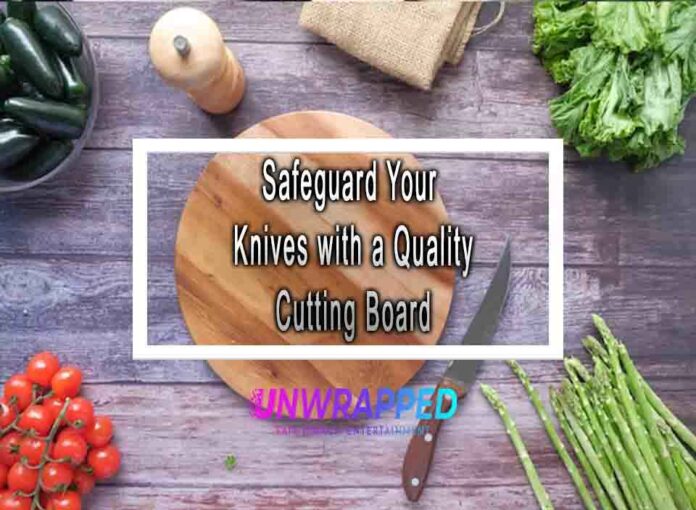Safeguarding your knives with a quality cutting board is essential to ensure both the longevity of your knives and the safety of your food preparation. Here’s a guide to help you choose the right cutting board:
1. Material:
a. Wood:
- Pros: Gentle on knife edges, naturally antimicrobial, and aesthetically pleasing.
- Cons: Requires regular maintenance (seasoning with mineral oil) to prevent warping and cracking. Can retain odors and stains.
b. Plastic:
- Pros: Easy to clean, dishwasher-safe, less maintenance, and less expensive. Available in various colors for food safety (e.g., red for meat, green for vegetables).
- Cons: Can dull knife edges over time, may develop cuts and grooves that harbor bacteria.

c. Bamboo:
- Pros: Similar to wood in terms of aesthetics and knife-friendliness. Sustainable and eco-friendly.
- Cons: Requires regular maintenance to prevent cracking. May not be as gentle on knife edges as other wooden boards.
2. Size:
Choose a cutting board that provides enough surface area for your food preparation needs without overcrowding your kitchen counter. Common sizes include small, medium, and large.
3. Thickness:
Opt for a thick cutting board (around 1 inch) as it provides stability and durability. Thin boards may warp or split over time.
4. Cutting Surface:
- Go for a board with a smooth and even cutting surface. Irregularities can lead to uneven cutting and are harder to clean.
5. Maintenance:
- Consider how easy it is to clean and maintain the cutting board. Wood and bamboo boards need regular oiling to prevent drying out, while plastic boards can be easily cleaned in a dishwasher.
6. Durability:
- A quality cutting board should be able to withstand years of use. Wood and bamboo can be sanded to remove cut marks, but plastic boards may need replacing over time.
7. Knife-Friendly:
- Ensure the cutting board is kind to your knives. A good cutting board should not dull or damage your knife’s edge.
8. Food Safety:
- If you use multiple cutting boards for different food types (meat, vegetables, etc.), make sure they are color-coded or clearly labeled to avoid cross-contamination.
9. Stability:
- The cutting board should not slide around on your countertop while you’re using it. Some boards have non-slip grips or rubber feet for added stability.
10. Style:
- Choose a cutting board that complements your kitchen decor and style. This is especially important if you plan to use it for serving as well.
11. Budget:
- Cutting boards come in a range of prices. While it’s tempting to opt for budget options, investing in a high-quality cutting board can save you money in the long run by extending the life of your knives.
12. Consider Multiple Boards:
- Depending on your cooking habits, it may be beneficial to have multiple cutting boards for different purposes (e.g., one for meat, one for fruits and vegetables).
Remember that the choice of cutting board material is a matter of personal preference and maintenance capacity. Regular cleaning, proper storage, and careful use will help keep your knives sharp and your food safe.











